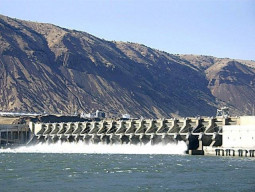
The authorities reported a better position of the country’s energy and water supply situation on Thursday a day after tempers began to fray nationwide over prolonged power outages and water scarcity amid the ongoing extreme heat wave.
Energy Minister Hammad Azhar said that the government added 1,200MW of electricity to the national grid, while the Indus River System Authority (Irsa) reported 385,000 cusecs water flow in rivers and dams.
In the past, the country’s chronic power crisis frequently triggered protests – sometime with violent consequences – in summers, but the incumbent government claims to have overcome the shortages by setting up several power projects under the China-Pakistan Economic Corridor (CPEC).
The energy minister attributed the current phase of load-shedding to a technical issue at a major hydroelectric power plant and outages at a few thermal power plants. However, he added that the outages didn’t mean the country doesn’t have surplus electricity.
According to experts, the demand for electricity is much higher compared to the projections of the government. "We are witnessing approx 15-20% more peak demand in power compared to last year," Hammad Azhar wrote on his official Twitter handle.
He said that the government has added 1,200MW of electricity to the national grid today [Thursday] and another 1,000MW will be added tomorrow. That should eliminate most problems," he further said, adding that extra 350 to 550MW electricity was being supplied to the K-Electric too.
Water position at different dams is the key to generating hydel power. The Irsa said on Thursday that glaciers melting because of the rising temperatures had improved the water situation, even creating floods in some rivers and canals in upcountry areas.
“The temperature in Skardu was recorded at 33° Celsius. The heat wave in Skardu and other parts of the northern areas increased the glacier melting process,” the Irsa said. Hence, it added, the flow of water in the Indus River at Besham has reached 229,000 cusecs.
The Irsa said that the total flow of water in rivers and dams reached 385,000 cusecs. “Tarbela Dam has an inflow of 173,000 cusecs and outflow of 100,000 cusecs. There is moderate flooding in Kabul River and a low level flood at Mangla in Jhelum river,” it said.
“The inflow to Mangla dam is 71,000 cusecs, it said, adding that the water level in Chenab river has also started rising rapidly that reached 60,000 cusecs at Marala. According to Irsa, the water storage in the dams was 1.948 million acre feet.
June is supposed to be the hottest month of the year. However, this year, the people are more worried about their school-going children after the government cancelled the summer vacations to compensate for long closure, owing to coronavirus pandemic.
The Met Office has forecast that a three-day rain spell is likely to occur from Friday (today) till Monday which would provide solace from scorching heat to the people of twin cities of Islamabad and Rawalpindi, Kahmir, Gilgit and parts of Punjab and Khyber Pakhtunkhwa.
“The prevailing very hot weather conditions will likely to subside during the wet spell,” Dr Zaheer Babar, the spokesman for the MET Office, Islamabad, said. He added that moist current from the Arabian sea would likely to “penetrate in eastern parts” of the country from Friday (today).

1732521023-0/biden-(1)1732521023-0-405x300.webp)
1732520496-0/BeFunky-collage-(86)1732520496-0-165x106.webp)
1732519472-0/lamar-(3)1732519472-0-165x106.webp)
1732519298-0/BeFunky-collage-(85)1732519298-0-165x106.webp)
















COMMENTS
Comments are moderated and generally will be posted if they are on-topic and not abusive.
For more information, please see our Comments FAQ